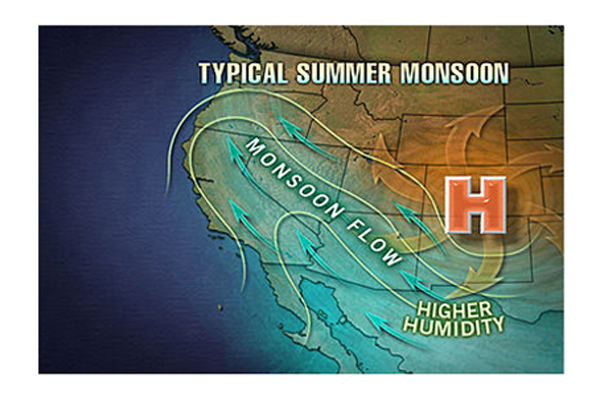
Monsoon Means More Moisture for West

This article was provided by AccuWeather.com.
Although many areas of the Desert Southwest and Rocky Mountains remain in a drought, some relief may be on the way in the coming months. The annual return of the North American Monsoon promises to bring thunderstorms to parts of the region through the end of the summer.
Similar to the summer monsoon that occurs across India, the North American Monsoon is characterized by a large increase in rainfall in the Southwest U.S. between June and July.
This large monthly disparity is shown clearly by average rainfall totals. For example, Phoenix receives 0.02 of an inch of rain on average in June followed by 1.05 inches in July. In Tucson this year, 0.34 of an inch fell in June, and 0.98 of an inch has already fallen through 11 days in July.
As the calendar turns to July, conditions become more favorable for rainfall across the region. Moisture streaming northward from the Gulf of California, eastern Pacific and Gulf of Mexico combines with the heating of the day to produce thunderstorms.
The most widespread and heaviest rainfall occurs in the mountainous regions during the monsoon where some locations receive over 10 inches during the summer. In the lower elevations, rainfall is less common, but short bursts of torrential rainfall can lead to flash flooding.
In addition to a flood threat, the summer monsoon plays a large role in determining the severity of wildfires. If the monsoon is active, the rainfall sets the stage for winter vegetation growth, leading to an increased fire risk the following spring.
Sign up for the Live Science daily newsletter now
Get the world’s most fascinating discoveries delivered straight to your inbox.
Meteorologist Mark Miller noted, "While the rainfall can be beneficial for drought-stricken areas, lightning strikes can also ignite wildfires."
After an exceptionally dry monsoon season in 2011 that was record-setting, this year's rainy season is forecast to be much closer to normal.
Last year, a large dome of high pressure situated itself over the Southwest, shielding the region from increased moisture. This season, that area of high pressure is located farther east, allowing moisture to stream into southwestern Arizona and southeastern California.
In addition, recent rainfall in Texas should allow more moisture to reach the Southwest as air flows northwestward from the Gulf of Mexico.
Tropical systems can also impact the amount of moisture flowing into the Southwest during the monsoon. Depending on their track, storms that form in the Pacific can turn into northern Mexico, promoting increased rain chances in the Southwest.
So far this year, the monsoon has been focused over western Arizona and southeastern California. As Expert Senior Meteorologist Alex Sosnowski states, "The mid- to late-summer phenomenon, known to locals as the monsoon, is getting involved... and will generate not only higher humidity to parts of the West, but also spotty thunderstorms."
© AccuWeather.com. All rights reserved. More from AccuWeather.com.









